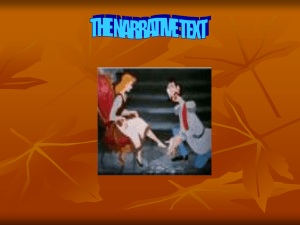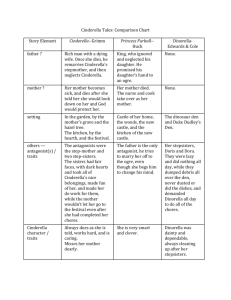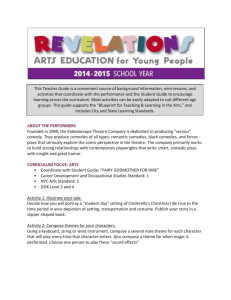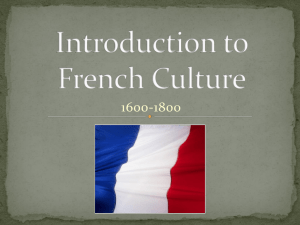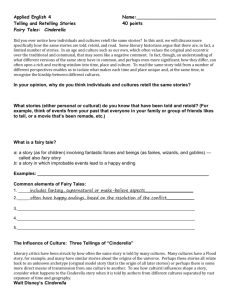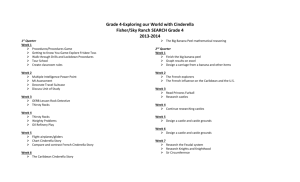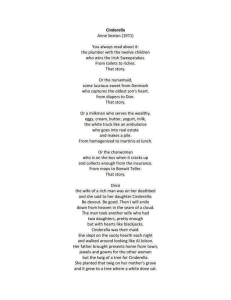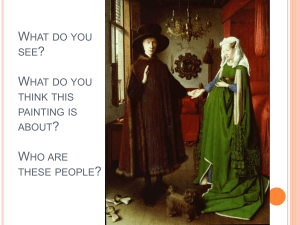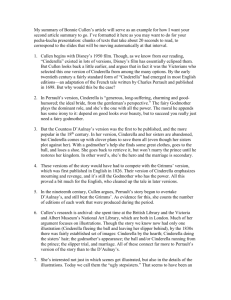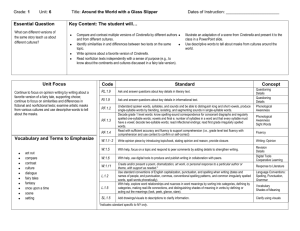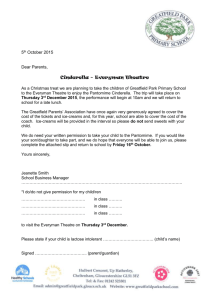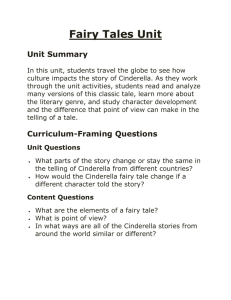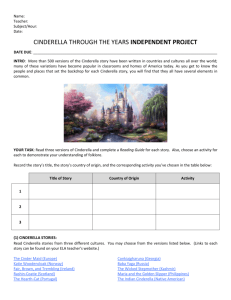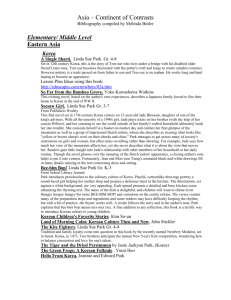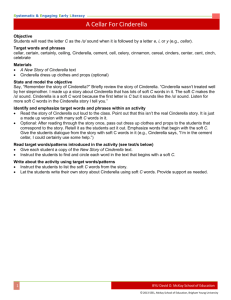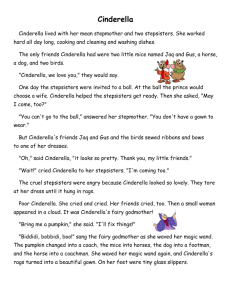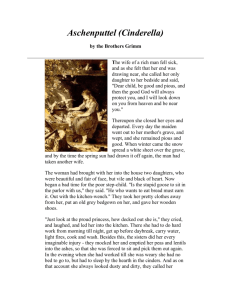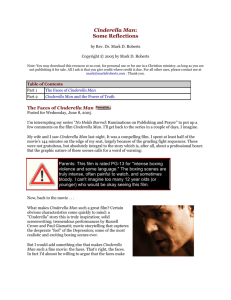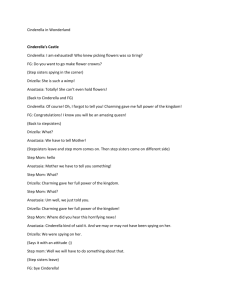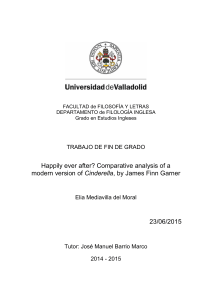Cinderella Tales Lesson
advertisement
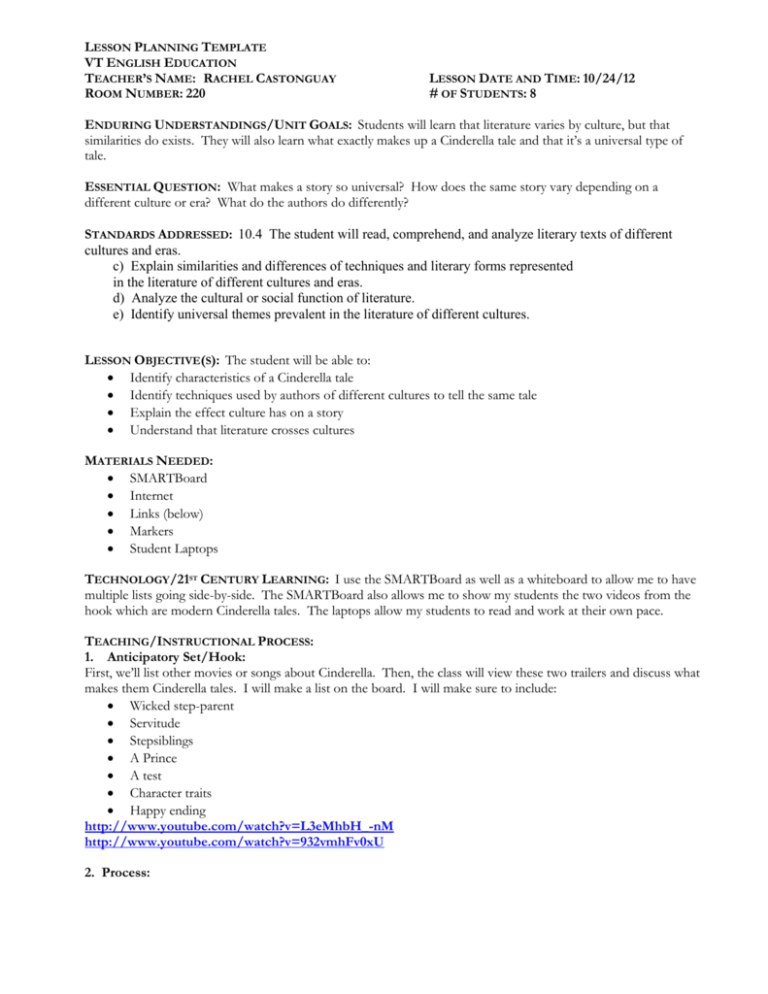
LESSON PLANNING TEMPLATE VT ENGLISH EDUCATION TEACHER’S NAME: RACHEL CASTONGUAY ROOM NUMBER: 220 LESSON DATE AND TIME: 10/24/12 # OF STUDENTS: 8 ENDURING UNDERSTANDINGS/UNIT GOALS: Students will learn that literature varies by culture, but that similarities do exists. They will also learn what exactly makes up a Cinderella tale and that it’s a universal type of tale. ESSENTIAL QUESTION: What makes a story so universal? How does the same story vary depending on a different culture or era? What do the authors do differently? STANDARDS ADDRESSED: 10.4 The student will read, comprehend, and analyze literary texts of different cultures and eras. c) Explain similarities and differences of techniques and literary forms represented in the literature of different cultures and eras. d) Analyze the cultural or social function of literature. e) Identify universal themes prevalent in the literature of different cultures. LESSON OBJECTIVE(S): The student will be able to: Identify characteristics of a Cinderella tale Identify techniques used by authors of different cultures to tell the same tale Explain the effect culture has on a story Understand that literature crosses cultures MATERIALS NEEDED: SMARTBoard Internet Links (below) Markers Student Laptops TECHNOLOGY/21ST CENTURY LEARNING: I use the SMARTBoard as well as a whiteboard to allow me to have multiple lists going side-by-side. The SMARTBoard also allows me to show my students the two videos from the hook which are modern Cinderella tales. The laptops allow my students to read and work at their own pace. TEACHING/INSTRUCTIONAL PROCESS: 1. Anticipatory Set/Hook: First, we’ll list other movies or songs about Cinderella. Then, the class will view these two trailers and discuss what makes them Cinderella tales. I will make a list on the board. I will make sure to include: Wicked step-parent Servitude Stepsiblings A Prince A test Character traits Happy ending http://www.youtube.com/watch?v=L3eMhbH_-nM http://www.youtube.com/watch?v=932vmhFv0xU 2. Process: 1. Once we brainstorm the list of characteristics of a Cinderella tale, the class will be divided up into 3 groups. Each group will be assigned one of three Cinderella tales (France, Norway, or Native American). 2. Each group will make a group handout with three columns: Cinderella characteristics, fairy tale/folk tail characteristics, and culture specific elements. 3. As a class, we will fill in our Cinderella characteristics column together. 4. Each group will go to the website where their text is located: http://www.amazon.com/Best-Loved-Folktales-Anchor-folktalelibrary/dp/0385189494/ref=sr_1_1?ie=UTF8&qid=1351052423&sr=81&keywords=best+loved+folktales+of+the+world+joanna+cole (In the look inside under first pages) http://www.surlalunefairytales.com/authors/asbjornsenmoe/eastsunwestmoon.html http://www.pitt.edu/%7Edash/type0510a.html#canada (The Indian Cinderella) 5. Each group will read their story and make notes to fill in their chart as they go. 6. We will use the Jigsaw activity to share what each group discussed. 7. As a class we’ll check off how many of our brainstormed topics occurred in our stories. 8. We’ll discuss the cultural traits and how students picked them. Specifically: 9. We’ll revise our list of Cinderella characteristics if necessary. 10. Students will then discuss authors technique (using cold call) to see if they used the same or similar strategies and how it effected the story. I’ll make a two-column list on the board of similar traits and author specific ones. 3. Check for Understanding/Closure: Most of my checking for understanding will come from listening to students discussions and the student-generated lists in steps 7, 8, 9, 10, and the hook. My closure will be a review of the lists we made and why. INDEPENDENT PRACTICE: The students are introduced to multiple versions of one tale to show just how similar cultures from around the globe can be. DIFFERENTIATED INSTRUCTION: I’m varying content by having three different tales and a list of characteristics that vary by class. The Jigsaw activity allows me to vary the process (as well as the size and composition of groups). My product will vary depending on what traits the students list on the final class Cinderella characteristics list and the T-chart of author techniques. INTERDISCIPLINARY COMPONENTS: There could be a connection to history and public speaking (the oral tradition). ASSESSMENT/RUBRICS: I will check for understanding by having students list what they think are Cinderella techniques. I will check again by walking around as students discuss their story and decide what to put on their chart. Another check will occur during Jigsaw when I will walk around to hear what students decide to share. Another check will come when students explain what cultural traits they picked (specifically why). An optional check is revising the list of characteristics of a Cinderella tale. Lastly, I’ll check by listening to students answers about authors technique.
